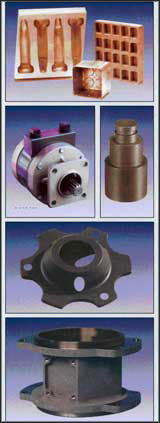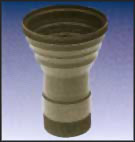Aluminum Anodizing
Type II – Clear and all colors
Type III – Hard Anodize
AMS 2468, AMS 2471, MIL-A-8625
An aluminum oxide coating for improving the hardness, lubricity and corrosion resistance of aluminum and aluminum alloys.
The HARDTUF Process
HARDTUF is a proprietary anodizing process developed by Tiodize Co. Inc. It is an electrochemical process for building a lubricative aluminum oxide coating on aluminum and it provides an extremely hard, corrosion resistant surface with high dielectric strength. The process converts the aluminum surface to aluminum oxide (Al203H20) and replaces
the H20 with Tiolon® (PTFE). The HARDTUF MIL Spec number is MIL-A-63576.
Teflon Impregnated Hard Anodize
![]()
Advantages:
- Lubricity
- Corrosion Resistance
- Wear Abrasion Resistance
- High Dielectric Strength
- Mold Release Properties

HARDTUF X20
This process is an impregnation of PTFE into the unsealed surface asperities of the oxide coating for better lubricity and mold release qualities.
HARDTUF A20
This process uses a PTFE coating suspended in a thermoplastic resin and applied by dipping spraying or brushing the unsealed oxide surfaces. This air-dry coating allows for better corrosion resistance and lubricity.
HARDTUF E20
In this process, PTFE is suspended in a thermosetting resin, applied by spraying dipping or brushing the unsealed oxide surface and cured at 375°F for one hour. E20 is used for longer wear life and solvent resistance.
The HARDTUF Advantage
Wear and Abrasion Resistance
HARDTUF resists wear and abrasion better than other mil spec type hard anodizing processes.
Lubricity
HARDTUF provides a dry lubricating surface composed of a PTFE polymer called Tiolon®. Tiolon® is impregnated into the surface asperities, thus reducing
surface tension and greatly increasing lubricity.
Corrosion Resistance
HARDTUF is more resistant to corrosion and most common chemicals due to the interlocking structure of PTFE and aluminum oxide. Its sealing effect is responsible for excellent salt spray resistance and other corrosion environment tests.
High Dielectric Strength
HARDTUF is a non-conductor and acts as an insulator. It will withstand a range of 1,000 to 2,000 volts, depending upon its thickness. Standard anodizing films break down at about 600 volts. HARDTUF becomes an integral part of the parent metal. It is the surface of the metal converted to an oxide and then interlocked with PTFE. It will not peel or strip; and because of its hardness, it resists nicks, scratches and will not flake by ordinary means.
Numerous applications on a variety of aluminum alloys

Applications:
- Molds/die products-used as a mold/die release to reduce sticking and wear
- Machinery-rotors, gears, bushings, bearings, etc.
- Electronics-heat sinks, control panels, capstans, data processing equipment
- Aerospace components-actuators, valves, impellers, etc.
- Automotive-mechanical parts, racing pistons
- Marine parts-boat spars, fittings, etc.
- Ordnance-all U.S. service branches require hard-coating

NOTE: Reason for difference in coating quality on die casting is that 218 is 9.4% alloying elements of which the principal is magnesium. Magnesium is not detrimental to HARDTUF and, in fact, there are some high magnesium proprietary sandcasting alloys (such as Almag 35) which anodize very rapidly and well, 360 and 380, however, are 11.60% and 13.80% alloying elements respectively, and the principal elements are silicon and copper. Both, but specifically silicon, are detrimental to a good anodic coating.
Characteristics as applied to:
Wrought Alloys
1100 Series
Most common: 1100 only Bronze-grey in color at .002 inch, alloy is soft and not particularly good for machining. Maximum practical coating thickness .0025 inch.
2000 Series
Most common: 2014, 2017, 2024, 2618 (forgings). Avoid sharp corners on 2011 and 2017; grey-black at .002 inch to blue-grey at .002 inch. Excellent machining coating .002 inch; .0025 inch possible for salvage though not as hard as less heavy coats.
3000 Series
Most common: 3003. Good for die work and machining. Grey-black in color at maximum coating of .002 inch.
5000 Series
- Most common: 5005, 5052. 5005 best for die work;
- 5052 not good for die work, except black. Both have good machining characteristics, Maximum practical coating .002 inch.
- 5052 has excellent dielectric properties when coated to .002 inch.
6000 & 7000 Series
Most common: 6061 6063 and 7075. 6061 forms excellent hardcoat for grinding, lapping or honing. Excellent dimensional stability. 6063 used for extrusions. Maximum practical coating .0025 inch. 7075 for high strength applications.
Tool Plate
Reynolds and Alcoa make high stability tool plate (wrought and cast, respectively). Both can be HARDTUF coated. Maximum practical coating is .0025 inch.
Ingot
Sandcast Alloys
Most common: 319, 355, 356, also 40E, Ternalloy, Tenzalloy and a variety of proprietary alloys. 356-T6 is used most often. Grinds and polishes very well. Porosity can cause apparent pits in coating. Anodize will not fill in pores. Maximum practical coating .004 inch.
Die Cast Alloys
Most common: 218, 360, 380. Only 218 produces hardcoat comparable to that on wrought or sandcast, 218 is difficult to die cast.
Maximum .0015 inch. 360, 380 maximum about 001 inch. Color is black. Not as wear resistant as 218.
Contact Tiodize Company, Inc.
Corporate Headquarters
5858 Engineer Drive
Huntington Beach, CA 92649
Tel: (714) 898-4377
Fax. (714) 891-7467
Sales & General Information:
E-mail: tiodize@tiodize.com
